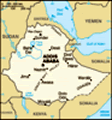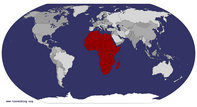Advertisement
Published: March 24th 2009
...is it safe? Every time I sit in a dentist's chair I have a vision of Laurence Olivier leaning over me with an evil hook-shaped tool in one hand and a bottle of clove oil in the other, about to ask me the un-answerable question "is it safe?".
Snapping back to reality, Laurence has been replaced by a bespectled Indian with an impressive face mask and set of ranged magnifying lenses attached to his glasses, not unlike the characature of a white-suited mad doctor that appear in so many computer video games. The drill starts whining, a grinning Nurse Ratched leans over and inserts a tube into my mouth as my gums go uncomfortably numb.
Tell me what the 'it' refers to? The rot had been started by the small stones that hide unnoticed in Ethiopian lentil dishes; unnoticed that is until #crunch# owww!!!, dinged by another split lentil dish.
There is clearly an art to removing stones from lentil dishes and clearly the art has not been mastered by all who prepare food in Assosa. With a couple of painful near misses, my upper left hindmost molar finally got the good news a month or

 Tuning into World Service
Tuning into World Service
...live second half match match commentary anyone?so back.
The inevitable was hastened by the Ferengis of Bude who kindly brought us a packet of Murray Mints and with it out fell half the big rear molar filling; followed a week later by the coup de grace on a particularly well fried bombolino.
To their credit VSO booked me onto a flight to Addis and permission to visit the official dentist at St Gabriel's Hospital on Hiya Hulet.
Having shelled out to register you wait for the Dentist to appear; shell out again for an x-ray, wait for it to be developed; then shell out again for a filling. After this shuttle diplomacy between Dentist's office and the cash office at reception, by way of several stints on the waiting room chairs you finally get the green light for surgery.
A live, freshly-cut nerve is infinately more sensitive... My initial fears about anything involving spilled blood and body fluids in a Ethiopian Hospital were underlined when I was ushered in to the office where a dental nurse sat with her finger knuckle-deep upside her right nostril.
Wondering if this a new route to those difficult-to-reach wisdom teeth I began to get

 Suspect that arial can get Radio Bristol!
Suspect that arial can get Radio Bristol!
Geek note: VHF hand-held and sat phone in handthe Babe Levy sweats and wished I'd checked the door name-plate for Dr Christian Szell.
Fortunately the dentist - a perfect gentleman from India - was a true professional, as was the nurse, who donned a pair of rubber gloves for the operation.
Everything was explained. I saw the x-ray and was told I was lucky as the missing tooth material was only a fraction away from the nerve and subsequent root canal surgery!
The dentist had been well recommended by other VSOs and they were not wrong.
So was it safe?
Yes it's safe, it's very safe, it's so safe you wouldn't believe it...
***********************************************************************************
A visit from the DSS Not a doorstep inquisition about an underpaid housing benefit claim from the mid-90s (as if) but a visit to Assosa by the United Nations Department of Safety and Security (UNDSS).
As workers for an NGO operating in the area we had been invited to attend a day long workshop on security, hosted by the UNHCR (High Commission on Refugees) and attended by UNDP (oh dear) and UNICEF (just Google it...).
We also saw staff from the IRC (International Rescue), Action

 Thuraya Satellite Phone
Thuraya Satellite Phone
Point to the stars and pay a small fortuneAid and ZOA (a Dutch refugee organisation).
What did we cover?
- A brief update on the security situation in Ethiopia
- Risk Management
- Field Mission Team Leader Responsibilities
- Minimum Operational Security Standards
- Ambush/Hijack drills
- Hostage Survival
- Landmines and UXO (unexploded bombs)
Set Phases on One Ethiopia has 5 borders, Eritrea, Djibuti, Somalia, Kenya and Sudan.
OK, apart from some craziness this time last year, Kenya is mostly cool, but the rest? Yikes! Time to get applying for a Masters in the States! (What? You already are?).
Plus the withdrawal of the Ethiopian troops from Somalia has created a security vacuum that could result in even more insurgents operating in the Somaliland region of Ethiopia (don't worry - VSOs are not allowed to go there).
The UNHCR has camps dotted around Ethiopia supporting Sudanese, Eritrean and Kenyan refugees, although many of the Sudanese refugees are slowly returning. Whether current events in Sudan will change this programme, I couldn't say.
We were briefed on the UN Security Phases, which was interesting as I recall Beneshangul-Gumuz was (and still is) at Phase 1 or "Yellow Alert" according to VSO

 Road to the rocks
Road to the rocks
Don't forget a packed lunch and a thermos(we have to start rocking around in our chairs, while lights flash, beepers buzz and cardboard scenery rocks to an incoming Klingon attack..)
So here is a breakdown of the phases, with a simple analogy for fans of 60's sci-fi series.
Phase #1 - Precautionary (Watch out for Klingons)
Phase #2 - Restricted Movement (the Klingons are here, stay indoors with the wife & kids)
Phase #3 - Relocation (Beam yourself and the science team outta there and leave the Klingons to the guys in red shirts)
Phase #4 - Emergency Operation (Away teams on life-saving/beautiful alien princess-saving missions only)
Phase #5 - Evacuation (Warp factor 9, Mr Sulu before 'the engines canna take it...')
The details of each phase were explained and how you can move up/down between them. Who gets to set the phases and so on. Phase setting has both political and financial implications for the UN and for the host country.
As phases get worse, tourists stop coming, company investment ceases, host countries lose money, UN staff demand hazard pay, relocating or evacuating staff costs money, equipment gets abandoned etc etc
To move a region to Phase 3 (Relocation of non-essential

 Left behind...
Left behind...
...I dillied and dalliedstaff) the UN Secretary General must sign off and the UN Ambassador for that country in New York will be told prior to the information being made public.
State of the Nation The presentation went around the regions of Ethiopia, detailing security risks and incidents - landmines from old wars, different armed groups known to operate in each region, areas of banditary, clan conflicts, abductions, bombings, draught, military operations, areas of increased crime etc.
The object of such an assessment is to make sure humanitarian operations can continue safely.
Ethiopia has only two phases in operation in Ethiopia. Phase 1 and Phase 3, which roughly equates to 'watch out' and 'essential staff only', respectively. VSOs are not allowed in any Phase 3 area (Danakil Depression or Somalia), but what was suprising is that the whole of Ethiopia if not Phase 3 is Phase 1 at the moment!
The reason Ethiopia is at Phase 1 everywhere is because of road traffic accidents. It is the number one threat in Ethiopia - and in fact the most common cause of death for VSOs world-wide. Apparently the vehicle numbers in Ethiopia are relatively low compared to other countries

 Give Us Shelter
Give Us Shelter
Under a (very slow moving) rolling stone...in the world, but the incidence of RTAs is one of the highest in the world.
Either the roads are very bad and/or full of cows, humans and donkeys, therefore difficult to drive on, or the roads are very good and speeding becomes a major risk.
Risk = Threat x Vulnerability We then spent an enjoyable hour (for me anyway) on how to carry our risk assessments and analysis. This stuff is my bag back in the Uk and I was, shall we say, more engaged than most.
Threat analysis was covered, based on analysis of the situation and a determination of threats.
Situational analysis included the current
political state: are NGOs expelled? Does the government support for humanitarian work? How about freedom of the press? Do opposition parties operate freely?
economic state: is it favourable for operations e.g. is the inflation rate ridiculous, like in Zimbabwe, are food prices causing civil unrest? is there a fuel embargo? Is it possible to buy food and equipment for operations?
social state: clan conflicts? crime? nationality of staff a problem?
infrastructure: roads? hospitals? housing for staff? sanitation? food?
security forces: military ops? armed militia? police presence and

 Inzy Hill from the Rocks
Inzy Hill from the Rocks
The second cut will reveal more...public confidence in? police co-operation?
environment: natural disasters? flood? draught? disease? volcanoes? what will hinder the operations?
Determination of threats looked at direct threats e.g. UN deliberately targeted or indirect threats e.g. staff may be in the wrong place at the wrong time.
The talk moved on to how to reduce risks - use serviced 4x4s, travel time limits, avoid bandit time (11am-3pm when the police are taking rest), don't be the first person on a road (let someone else hit the mine first!), training, guards, escorts, body armour, shatter-proof glass, Minimum Operating Security Standards (MOSS), ballistic blankets (stops mine blasts), standard operating procedures for each security phase and so on.
Aye, aye, Capt'n A whole section on Team Leader Responsibilities when conducting a Field Mission by Road followed, which was interesting but pretty irrelevent to us.
It covered pre-departure preparation with threat evaluation, team leader responsibilities (check vehicle, meet all mission members, obtain security clearance etc), pre-departure briefing, route planning, communications, MOSS for Field Vehicles, convoy movement guidelines and debriefing.
The rules for communications using the High Frequency (HF) and Very High Frequency (VHF) radios when travelling by road were introduced and (lucky

 Gis'a hug
Gis'a hug
That's better!old me) there would be a training session on the following morning on how to use the UN HF, VHF and Satellite telephones. Geek boy delight 😊
Hands where we can see them... The next session covered vehicle hijacking, best practice, indicators of imminent hijacking, actions to take during a hijack and evasive action.
Some interesting pointers there.
- Look for people in cars tail-gating you and making angry or animated gestures.
OK. Best I give the outside lane of the M32 a miss based on that assessment!!!
- Vehicles undertaking.
Hmm. Now does that make every BMW driver a potential hijacker???
One key point to remember is your vehicle is the target, not you, so if there is no possible way of escape, stop. Do not resist, keep hands in view and explain what you are doing i.e. "I am taking off my seat belt" in case someone thinks you are reaching for a weapon.
The advice was also NOT to trip any anti-hijack mechanisms like the fuel cut off as hijackers now take you with them as a temporary hostage until the vehicle has passed any usual fuel cut-off

 Looking back
Looking back
Dharma Initiative Agricultural research station on left and prison on extreme rightthresholds.
If you decide to take evasive action, do it immediately and be prepared to damage property, risk injury to yourself and others and break local traffic laws. If all the people want is your car, let them have it, rather than kill a few pedestrians, write the car off and cripple yourself in an accident!
That said, if you want to ram a car, hit the side/rear at 90 degrees and drive through the other vehicle..
...er, oops! hope those M32 tailgaters aren't reading this too 😉
enjoy a brief clove oil respite and tune in for incision #2 soon ###
Advertisement
Tot: 0.084s; Tpl: 0.011s; cc: 7; qc: 23; dbt: 0.0282s; 1; m:domysql w:travelblog (10.17.0.13); sld: 1;
; mem: 1.1mb











